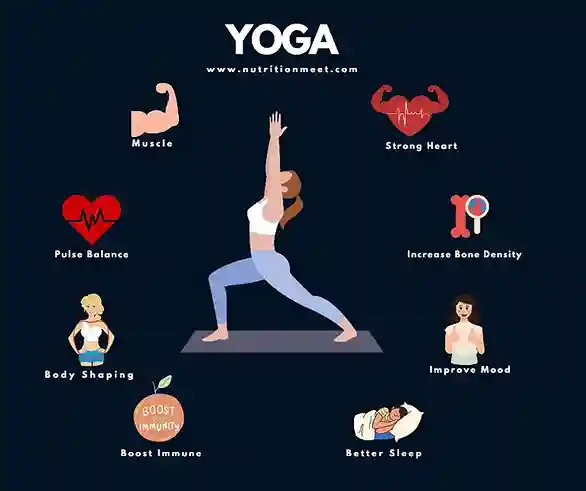Seeing all around me talking and practicing yoga, I got excited to learn more and more about yoga; In my early research, what is the history of yoga and types of Yogasana? I learned a few things about the benefits of Yoga, like it improves flexibility, strength, balance, and quality breathing, which helps with stress and anxiety. But the interesting thing is that yoga is more than an era age-old and ancient practice. Around the world, people call Yoga a form of meditation.
Since Yoga aid in stress, relaxation and meditation, and many other health conditions, let’s delve deeper into the history of yoga.

Table of Contents
Beginning of yoga
The meaning of yoga in Sanskrit is “to unite.” The term “yoga” was first used in a sacred text called Rig Veda. According to ancient history and sacred books, to realize the true nature of the self, a yogi turns his mind inward and detaches himself from all materialist things of this world. To achieve this, a yogi can use one or more yogic practices, such as Bhakti (spiritual), Karma (duty and action), and Jnana (Knowledge). In harmony, Patanjali’s second aphorism also states that “Yoga is the control of conscious mind and mental operations” (Yogah Chitti Vritti Nirodah)
Exactly since when yoga was practiced, there is no clarity about it, but according to current knowledge, yoga roots are dated back between 2500 and 5000 years ago in the Indus Valley civilization, since the earliest images of yoga were found in soapstone seals at the archeological site of Mohenjo-Daro, India [1].
Yoga is a centuries-old culture in India; however, it has gained popularity in the United States and worldwide because of its physical and mental health benefits.
To get started with yoga, the basic rule is to know the “posture” called “asana in Sanskrit” because, without a correct posture, it is not possible to attain peace of mind. Moreover, there is no specific guideline or form; instead, any steady and pleasant posture is considered suitable. In addition, Vachaspati describes asana as “any position that may secure ease.” [2]
5 Types of Yogasana
Hatha yoga
Hatha can be broken into two terms, i.e., “ha- stands for Sun” & “tha- stands for Moon,” which symbolize the flowing of breath. “Sun breath’ and ‘moon breath’ a flowing of breath from the right nostril and left nostril, respectively. Nevertheless, “Hatha yoga is the uniting of these two breathes.” [2]
Hatha yoga mainly focuses on psychophysical practice involving various bodily and mental controls.
Ashtanga yoga
Ashtanga yoga talks about eight parts of “limbs,” hence the name “asta- eight, anga- limb.” The eight limbs are as follows:
- Yama = restraints, self-control, abstaining
- Niyama = observance, self-training
- Asana = posture, seat
- Pranayama = control of breath; Breath and prana expansion
- Pratyahara = withdrawing the mind from sense perception, internal focus
- Dharana = concentration
- Dhyana = meditation
- Samadhi = super consciousness, perfect focus, deep absorption [3]

Vinyasa yoga
The “Vinyasa” is made up of two words “Vi, meaning variation”; “Nyasa, meaning within prescribed limits.” It is also known as “flow,” where you fluently move from one pose directly into the next. Since you are transiting from one pose to another, you tend to increase your heart rate and let your body work harder.
According to one of the studies, vinyasa yoga is the most popular mindfulness exercise to improve overall health and promote weight loss compared to traditional aerobic exercise.
Kundalini yoga
Kundalini yoga is a medium to activate the energy that lies within the body, either at the navel or the base of the spine. This energy remains in the dormant state unless evoked and channelized upwards through a central channel in the process of spiritual perfection. Kundalini is a power believed to adhere to shakti (divine feminine).
Iyengar yoga
Iyengar yoga developed by and got its name after B K S Iyengar. It stresses precision and alignment while practicing yoga exercises. It differs from other types of yoga in three ways, i.e., precision, sequence, and use of props.
At times if you are a beginner or elderly person, you may use props to perform the asana correctly [10].
Aerial yoga
It is a hybrid type of yoga developed with a mixture of yoga poses, Pilates, and dance with the support of a hammock (Sling made up of fabric, rope, or net) suspended from the sealing.
The Vrksasana (tree pose), Matsyasana (supported fish pose), Ardha Kapotasana (half pigeon pose), and Supta Konasana (reclined angle pose) are some of the aerial yoga poses.
The fear, injuries, bruises, and struggle to learn new movements are some of the challenges associated with aerial yoga [11].

Best 7 days Intermittent fasting diet plan Indian

The Truth About Calorie Counting: Balancing Weight Loss and Mental Health
Benefits of Yoga
It’s quite possible that if you are under mindful yoga practices, you will have the following benefits [5]:
- Decrease in anxiety and mental stress.
- Better muscular fitness helps build muscle mass and strength.
- Improvement in muscular flexibility
- Balance control improvement
- Improves self-esteem and mood
- Improves sleep patterns
- Regulates breathing
- Better quality of life
- Weight maintenance
- Improves immunity power
To summarize, practitioners of yoga can achieve peace, calmness, and better completeness in their life with the interconnection of mind, body, and spirit [8].
Except for these benefits of yoga, there are numerous therapeutic benefits as well. In short, therapeutic yoga is a form of practice where yogic postures and practices are utilized to treat a particular health condition.
You may take these teachings to prevent or reduce physical, emotional, structural, or spiritual suffering [6].
For instance, yoga can reduce aches and pains in any part of the body since continuous practice loses the muscles and connective tissues surrounding the bones and joints.

In fact, the full motion of joints especially is not most often used, letting the flow of fresh nutrients, oxygen, and blood hence conditioning that specific area of the body, which eventually can prevent arthritis and chronic pain [9].
The internal defense of our body is T cells which are heterogeneous in nature and protect our body from foreign invaders, i.e., Bacteria, viruses, fungi, etc. When one practices yoga, it activates thymus glands (located between the heart and breast), which produce T cells, hence the activation of immunity to fight even a pandemic like COVID-19 [8].
According to the research, yoga is beneficial in decreasing hypertension by reducing systolic and diastolic BP approx. 10 mmHg and 8 mmHg, respectively [12].
According to WHO, 80% of deaths are caused by four main diseases, i.e., cardiovascular disease, cancer, diabetes, and respiratory diseases. Nevertheless, Yoga is a kind of alternate therapy or can be used in combination with other therapeutic methods to treat cardiovascular diseases (CVD), diabetes, respiratory diseases, cancer, allergies, acid peptic diseases, irritable bowel syndrome, etc. [13]
Surprisingly, oral health and hygiene are also connected with yoga since it improves lifestyle, reduce stress, and reduces gingival inflammation (concerning gums) [7].
FAQ
History of yoga in India?
Still, there is debate on when yoga practice started; however, according to the available literature on the history of yoga, it started over 5000 years back.
History of Yoga Vedic period?
During the Vedic period, yoga was the medium of development of concentration and transcended the mundane. The definition of yoga during the Vedic period was to unite the individual self with the supreme self.
What are the yoga benefits for the skin?
Microcirculation oxygen brings more oxygen to cells when you practice yoga and breathing exercises; hence the face looks calm, and your complexion looks more balanced and radiant.





